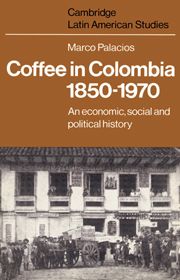The only one-volume history of Colombia in English is David Bushnell, The Making of Modern Colombia: A Nation in Spite of Itself (Berkeley, 1993). One useful volume which embodies recent trends in the historiography is Darío Jaramillo Agudelo (comp.), La nueva historia de Colombia (Bogotá, 1976). This is complemented by Jaime Jaramillo Uribe et al., Manual de historia de Colombia, vol. 3 (Bogotá, 1982), and a contemporary reader, Mario Arrubla et al., Colombia: Hoy, 2nd ed. (Bogoté, 1978).
politics and society
On the politics of the 1930s and 1940s, see Daniel Pécaut, L’Ordre et la violence: Evolution socio-politique de la Colombie entre 1930 et 1953 (Paris, 1986); Christopher Abel, Política, iglesia y partidos en Colombia, 1886–1953 (Bogotá, 1987); and Terrence Burns Horgan, ‘The Liberals come to power, por debajo de la ruana: A study of the Enrique Olaya Herrera administration, 1930-1934’ (unpublished Ph.D. thesis, Vanderbilt University, 1983). Alvaro Tirado Mejía, Aspectos políticos del primer gobierno de Alfonso López Pumarejo, 1934–1938 (Bogotá, 1981), is a valuable introduction from a committed lopista perspective. On the economy, there are Rosemary Thorp and Carlos Londoño, ‘The effect of the Great Depression on the economies of Peru and Colombia’, and José Antonio Ocampo, ‘The Colombian economy in the 1930s’, in Rosemary Thorp (ed.), Latin America in the 1930s: The Role of the Periphery in World Crisis (London, 1984), which should be read with José Antonio Ocampo and Santiago Montenegro, Crisis mundial, protectión e industrializatión: Ensayos de historia economíca colombiana (Bogotá, 1984), Alvaro Tirado Mejía (ed.). Estado y economia (Bogotá, 1986) and Paul W. Drake, The Money Doctor in the Andes: The Kemmerer Missions, 1923–1933 (Durham, N.C., 1989).
